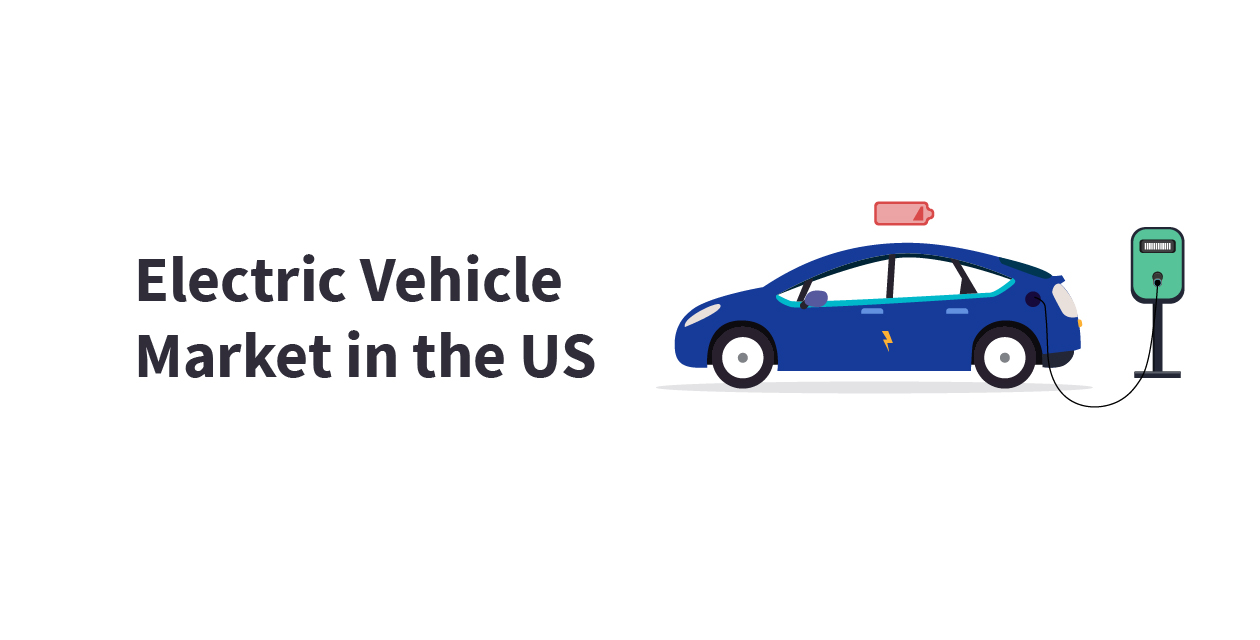The transformation of the global automotive industry is palpable, and at the center of this seismic shift lies the US electric vehicle market. This critical market has become a forerunner for the adoption and expansion of electric vehicles (EVs) worldwide.
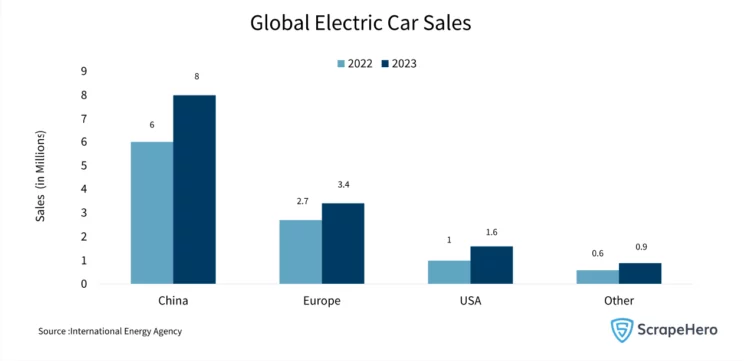
Electric vehicle sales globally have been surging, driven by consumer awareness, government incentives, and technological advancements. The United States, in particular, has been a hotbed for this change, with top electric vehicle companies focusing on the American consumer. The list of EVs available in the country has grown exponentially, making it easier for consumers to find a model that suits their needs.
This article aims to provide a comprehensive overview of the current state of the US electric vehicle market, examining not only the surge in vehicle adoption but also the readiness of the existing charging infrastructure to meet this rising demand. Through data-driven insights and expert analysis, decision-makers and stakeholders can make informed choices that will shape the industry’s future.
EV Market in the US: States Leading the Charge
As the US electric vehicle market continues to expand, certain states are emerging as frontrunners in EV adoption. These states not only showcase impressive electric vehicle sales but also excel in creating a supportive environment, including ample EV charging station locations. For the purpose of this article, we have studied 18 major EV dealerships in the US. This section provides a detailed look at the states that are paving the way for a greener future.
States With the Most EV Dealerships in the US
States with the most electric vehicles in the US were primarily those with strong incentives, infrastructure, and policies supporting green transportation.
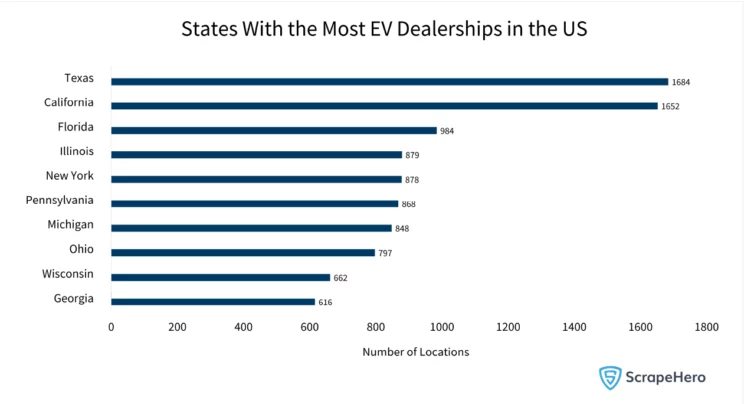
Texas
Though Texas has been traditionally associated with oil and gas, it is becoming an important market for top-selling electric vehicles. As of 2023, there are 1684 electric vehicle store locations in Texas. The state is offering various incentives and developing EV charging station locations to catch up with the growing EV market in the US.
California
California undoubtedly leads the pack when it comes to EV market share in the US. With policies that favor clean energy and a consumer base that is increasingly eco-conscious, California serves as a blueprint for other states.
States With the Most EV Registrations in the US
When examining the US electric vehicle market, regional disparities become apparent, shedding light on the varying levels of EV adoption across states. A striking observation is that California leads the pack in electric vehicle registration among the US states, trailed by Florida and Texas. This geographic distribution offers invaluable insights into how the EV market in the US is evolving.
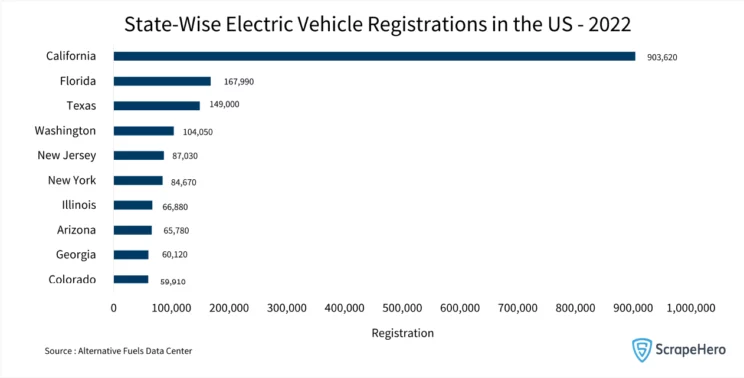
California leads the U.S. in electric vehicle (EV) registrations primarily due to its forward-thinking environmental policies, which include financial incentives like rebates and other incentives for EV buyers. The state’s extensive charging infrastructure and the presence of tech hubs like Silicon Valley further boost EV adoption.
Leaders in the US Electric Vehicle Market
In the rapidly evolving landscape of the US electric vehicle market, specific models have emerged as front-runners, significantly impacting electric vehicle sales. A focus on top-selling electric vehicles provides an understanding of consumer preferences and the technological advancements driving these sales.
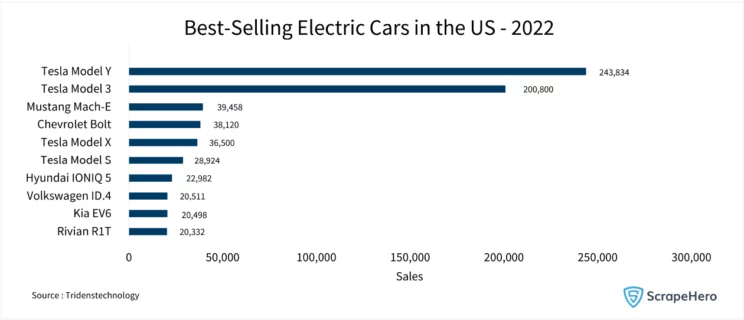
Unsurprisingly, Tesla dominates the list of EVs that Americans are buying. As of 2022, the Tesla Model Y tops the chart with approximately 243,834 sales, followed closely by the Tesla Model 3, which boasts around 200,800 sales. These figures indicate Tesla’s significant role in the EV market in the US, essentially shaping the trends and consumer behaviors around electric vehicles.
But why do these specific models enjoy such popularity? Top electric vehicle companies like Tesla have invested heavily in technology, performance, and range, factors that are high on the list of consumer priorities. The models’ features are aligned with what the American consumer is seeking, thereby naturally placing them at the forefront of electric vehicle sales.
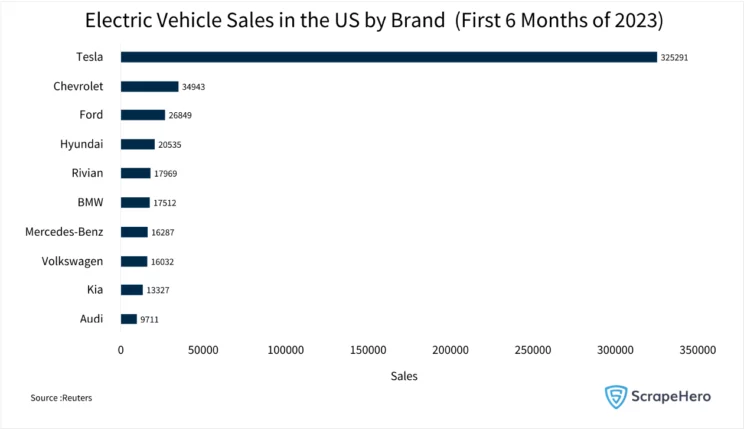
Many new electric vehicle models are being introduced by international automakers in the US, and new EV and battery plants are receiving billions of dollars in investment. A Reuters study of U.S. EV sales statistics for the first half of 2023 revealed that few of them, aside from Tesla’s Model Y and Model 3, are selling at levels that would justify a large-scale manufacturing plant.
Tesla’s Model Y and Model 3 stand as landmarks in the continuously expanding US electric vehicle market. Their sales figures set them apart, offering crucial data points for stakeholders aiming to understand consumer behavior, market trends, and the effectiveness of EV charging station locations. It’s a symbiotic relationship: as these models continue to sell, they simultaneously drive advancements in infrastructure and technology, shaping the future of the electric vehicle landscape in the United States.
Trends in the US Electric Vehicle Market
As the US electric vehicle market matures, several trends are crystallizing, offering a roadmap for the industry’s future. To get a nuanced understanding, this section discusses EV sales by model, the contrasting sales figures of battery electric vehicles (BEVs) and plug-in electric vehicles (Plug-in EVs), and the top electric vehicles in the US with the longest range.
The Dominance of SUVs
SUVs have emerged as the dominant choice among American consumers, constituting a significant 60% of total electric vehicle sales as of 2023. This preference aligns with the larger automotive market trend, where SUVs have long held a commanding presence. These models meet consumer demand for space and versatility, making them a natural fit for the burgeoning list of EVs in the US. Large cars follow at 22%, while small and medium-sized vehicles collectively account for 11%.
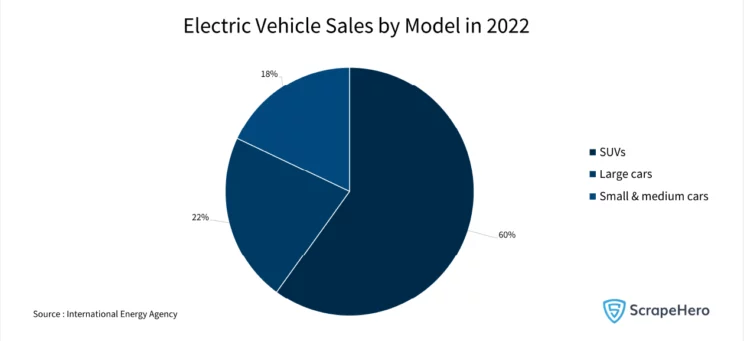
Battery EV vs. Plug-in EV Sales in the US
If one looks at the numbers, it’s clear that Battery Electric Vehicles (BEVs) have a considerable edge over Plug-in EVs. In 2016, BEV sales amounted to a mere 0.46 million, while Plug-in EVs trailed with 0.16 million. Fast forward to 2022, and BEV sales have catapulted to 7.3 million, with Plug-in EV sales lagging at 0.92 million. This disparity in growth rates highlights the shift in consumer confidence towards fully electric models, which have a more substantial impact on the EV market share in the US.
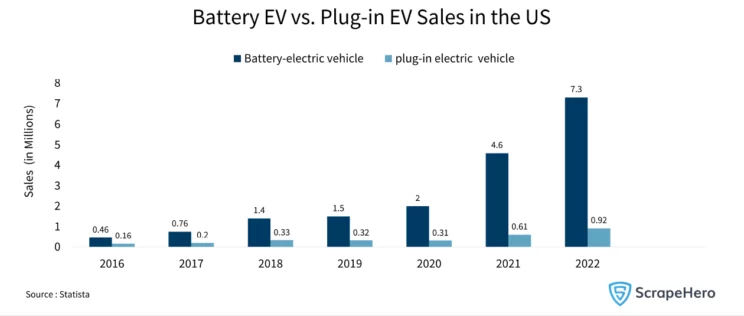
Range
In electric vehicles, ‘range’ refers to the distance the vehicle can travel on a single full charge of its battery. It’s measured in miles or kilometers and is a key factor people consider when buying an EV. When it comes to top electric vehicles in the US with the longest range, the Tesla Model S Long Range sets the bar high, providing more range than its competitors. This is a critical factor for many consumers, as range anxiety has often been cited as a roadblock to widespread EV adoption. With improvements in battery technology, top electric vehicle companies are focusing more on the range, effectively allaying consumer fears.
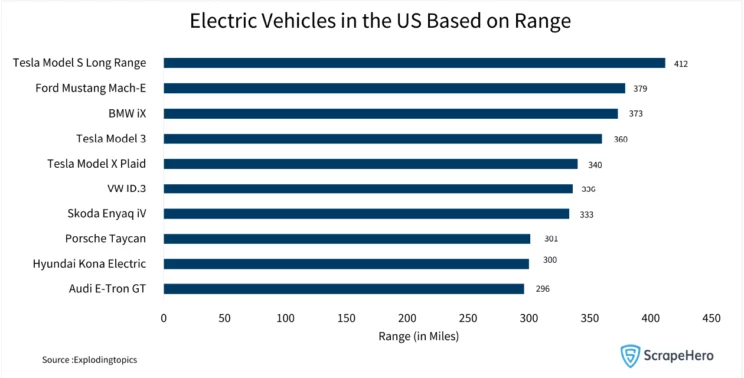
Charging Infrastructure of the US Electric Vehicle Market
The charging infrastructure is a critical element in the evolving landscape of the EV market in the US. It serves as both a catalyst and a support system for the growing electric vehicle sales, influencing consumer choices and future investment strategies. As the infrastructure continues to expand and adapt, it will play an increasingly central role in shaping the US electric vehicle market.
Download EV charging station location datasets for a better understanding.
Geographical Distribution
When it comes to states leading in infrastructure, California once again takes the spotlight, followed by New York and Florida. As of 2023, there are 15,114 charging stations in California and 3574 stations in New York. These states have significantly invested in EV charging station locations, facilitating easier and more convenient use of electric vehicles. This investment not only boosts EV sales in the US but also significantly contributes to the overall EV market share in the US.
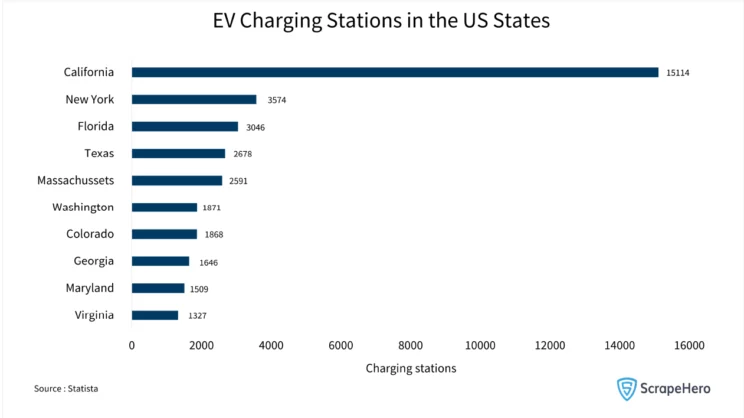
Top Charging Networks in California
In California, Tesla Destination Chargers, Tesla Superchargers, and Volta Charging network dominate the scene. Given the state’s role in shaping the US electric vehicle market, these networks significantly influence trends and adoption rates. The availability of multiple options provides consumers with the flexibility to choose based on their specific needs.
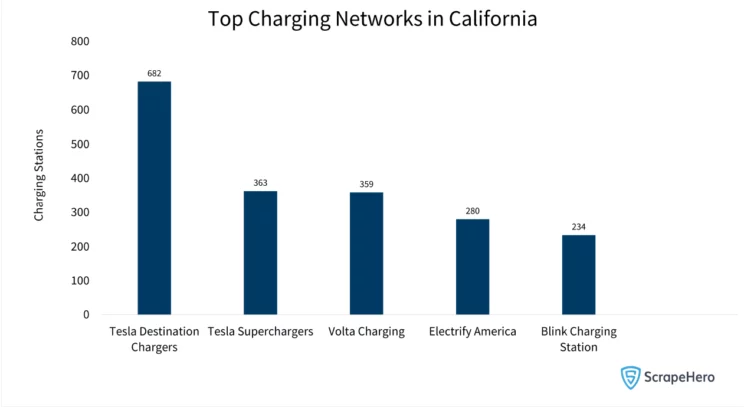
Charging Stations by Leading Network
Diverse networks cater to the charging needs of electric vehicles, with names like Tesla Destination Chargers, Tesla Superchargers, and Blink Charging Station network leading the pack. These networks are integral to the list of EVs compatible with them, thereby influencing consumer choice and electric vehicle sales.
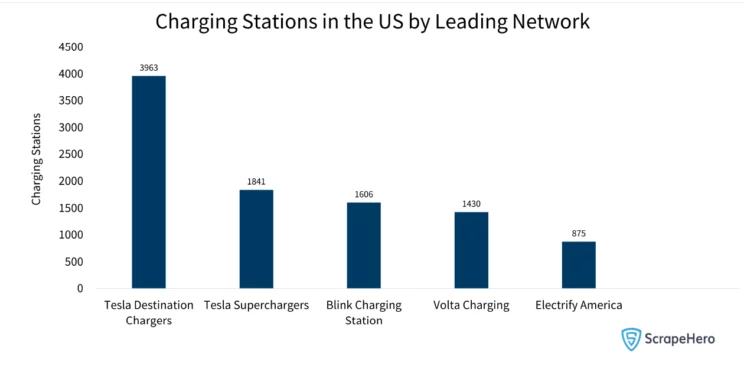
Tesla Charging Stations Across the US
Tesla’s charger network has set a standard in the industry. California leads with 1045 Tesla charging stations, followed by New York, as of 2023. With thousands of Superchargers spread across the country, Tesla has effectively alleviated one of the most significant barriers to EV adoption—range anxiety. This has not only boosted sales for Tesla but has also set a precedent for other top electric vehicle companies to follow.
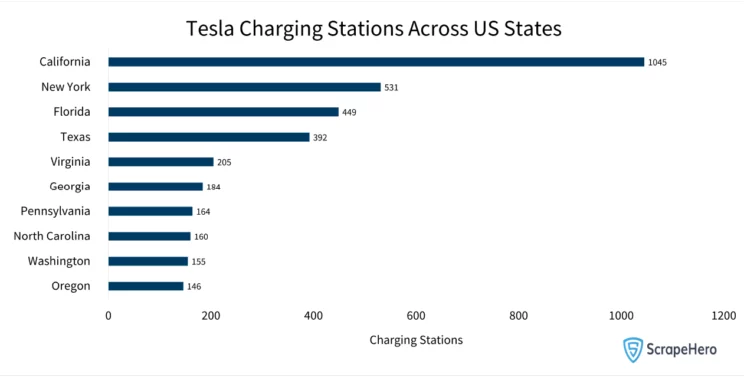
Final Thoughts
Looking ahead, the trends indicate a promising surge in the EV market share in the US. Advances in technology, improved battery ranges, and expanded EV charging stations in the US are poised to further drive the demand. Top electric vehicle companies are continually innovating, making electric vehicles not just an alternative but a standard choice for American consumers.
The US electric vehicle market is not merely surviving; it is thriving and poised for exponential growth. The pieces are in place: the technology, the infrastructure, and, most importantly, an ever-growing consumer base willing to embrace sustainable transportation options. The data doesn’t lie; the future of the American electric vehicle market is electric, indeed.
Market stakeholders would do well to keep a keen eye on these developments. Understanding regional disparities in EV sales in the US will be critical for tailoring localized strategies. Equally, insights into consumer preferences, ranging from vehicle models to charging networks, will shape future investment and expansion plans.
Enhance your strategy with comprehensive location datasets and get detailed insights on EV charging stations, top industry players like Tesla, and more. Visit the ScrapeHero Data Store and make data-driven decisions that matter.
Frequently Asked Questions (FAQ)
- What is the EV market trend in the US?
In the United States, SUVs constitute a significant 60% of total EV sales, making them the dominant choice among consumers. Additionally, battery electric vehicles (BEVs) have seen a dramatic increase in sales from 0.46 million in 2016 to 7.3 million in 2022. - What is the current EV market?
The current US electric vehicle market is characterized by increasing diversification in the list of EVs available and growing infrastructure, particularly in terms of EV charging station locations. States like California, Florida, and Texas are leading in EV adoption. - What is the biggest EV market in the US?
California is the biggest market for electric vehicles in the United States, with the most registrations and a considerable contribution to the EV market share in the US. The state’s proactive environmental policies make it an attractive market for top electric vehicle companies. - How big is the US electric vehicle market?
The US electric vehicle market is steadily expanding, driven by technological advances, policy incentives, and consumer demand. While exact figures can vary, the undeniable trend is towards exponential growth. - What is the demand for EVs in the US?
Demand for electric vehicles is robust, and EV sales in the US have been consistently rising. Factors such as extended battery life, increased availability of EV charging stations in the US, and environmental awareness are contributing to this growing demand. - What is the future market of electric vehicles?
The future market for electric vehicles in the United States appears promising. As technology and infrastructure evolve, the EV market in the US is expected to expand further. Innovations by top electric vehicle companies and increasing consumer willingness to transition to EVs indicate a sustainable and growing market.

